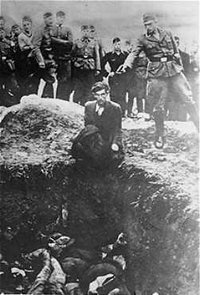Einsatzgruppen
|
|

Einsatzgruppen (a German military term meaning "mission groups") were semi-military groups formed in Nazi Germany before and during World War II. These death squads belonged to the SS and followed the Wehrmacht in their attacks first on Poland and then the Soviet Union. Their mission was to eliminate all sources of resistance to German domination, increasingly radicalized in their ambition by racial principles. They killed "undesirable" people ("anyone who gives us sharp looks", as Hitler said), almost exclusively civilians, without judicial review and later without semblance of legality (no reading of sentences of martial or administrative law were read), starting with the Polish intelligentsia and eventually including Jewish women and children.
| Contents |
History
After the occupation of Poland in 1939, the Einsatzgruppen killed Poles belonging to the intelligentsia, such as priests and teachers. The Nazis considered all Slavic people Untermenschen, or subhumans, and wanted to use the Polish lower classes as servants and slaves. The mission of the Einsatzgruppen was therefore the forceful depoliticisation of the Polish people and the elimination of the groups most clearly identified with Polish national identity.
After the invasion of the Soviet Union in 1941, the Einsatzgruppen's main assignment was to kill Communist officers and Jews which they did on a much larger scale than in Poland. They were under control of the RSHA; i.e., under Reinhard Heydrich and his successor Ernst Kaltenbrunner. They murdered more than a million Jews, Communists, prisoners of war, and Roma (Gypsies) in total. They also assisted Wehrmacht units and local anti-Semites in killing half a million more. They were mobile forces in the beginning of the invasion, but settled down after the occupation.
The standard method employed by the Einsatzgruppen was to post a proclamation ordering all the Jews and other condemned people in an occupied area to gather on a certain day. Once their victims were assembled, the squads led them to the place where they were to be killed, which was usually an open, isolated area where mass graves had been prepared. Sometimes, natural features of the landscape like the ravine at Babi Yar were used. The victims were forced to surrender their belongings and undress, after which they were positioned either on the edge of the grave or in it and shot.
The Nazis were not satisfied with shooting as a method of mass murder, however. It was costly in ammunition and effort, there were too many potential witness to the murders, and the constant, close-quarters killing of defenseless men, women and children took a heavy psychological toll on the killers themselves. The men in charge of the Final Solution began searching for an alternative.
In some areas, the Einsatzgruppen also brought along specialized trucks called gas vans, developed for the since-terminated T4 euthanasia program operated by the Reich Chancellery. Victims were forced into the backs of vehicles into which the exhaust from the engine was routed. The victims were then variably poisoned, and/or asphyxiated from the carbon monoxide accumulating within the truck compartment as the vehicle travelled to a burial pit. Gas trucks were subsequently employed at the Chełmno extermination camp. The stationary gas chambers of the subsequent death camps of Poland were an outgrowth of this idea, resourced by T4 staff on loan to the SS.
At the conclusion of World War II, senior leaders of the Einsatzgruppen were put before courts of the American Occupation, variably charged with crimes against humanity, war crimes, and membership in the SS (which had been declared a criminal organization), in what became known as the Einsatzgruppen Trial of the Subsequent Nuremberg Trials. Fourteen death sentences and two life sentences were among the judgments, although only four executions were carried out, on June 7, 1951, and the rest of these sentences were commuted.
Organization
- Einsatzgruppe A for the Baltic Republics with
- Sonderkommandos 1 a and 1 b (German for special forces, not to be confused with the Sonderkommandos in the concentration camps)
- Einsatzkommandos 2 and 3. Attached to Army Group North.
- Einsatzgruppe B for Belarus with
- Sonderkommandos 7a and 7 b, the
- Einsatzkommandos 8 and 9, and also
- a "special force" in case Moscow was captured. Attached to Army Group Centre.
- Einsatzgruppe C for the Northern and central Ukraine
- Sonderkommandos 4 a and 4 b and
- Einsatzkommandos 5 and 6. Attached to Army Group South.
- Einsatzgruppe D for Bessarabia, the Southern Ukraine, the Crimea and (eventually) the Caucasus with
- Sonderkommandos 10 a and 10 b and
- Einsatzkommandos 11 a, 11 b and 12.
both Attached to Army Group South.
Einsatzgruppen leaders
- Group A: SS-Brigadeführer Dr. Franz Walter Stahlecker (until 23 March 1942)
- Group B: SS-Brigadeführer Artur Nebe (until Oct. 1941)
- Group C: SS-Gruppenführer Dr. Otto Rasch (until Oct. 1941)
- Group D: SS-Gruppenführer Prof. Otto Ohlendorf (until June 1942)
See also
- Babi Yar
- Rumbula
- Generalplan Ost
- Holocaust
- Odessa Massacre
- Operation Barbarossa
- Operation Tannenberg
- World War II atrocities in Poland
Secondary sources
- The Origins of the Final Solution, Christopher Browning, 2004
- Masters of Death, Richard Rhodes, 2002
External links
- The Einsatzgruppen (http://www.shoaheducation.com/einsatz.html)
- Einsatzgruppen (http://www.ushmm.org/wlc/en/index.php?ModuleId=10005130&Type=normal+article) at the Holocaust Encyclopedia.
- Einsatzgruppen - Mobile Killing Units (http://www.rumbula.org/einsatzgruppen_latvia.htm)de:Einsatzgruppen der Sicherheitspolizei und des SD
fr:Einsatzgruppen he:איינזצגרופן nl:SS-Einsatzgruppen pl:Einsatzgruppen pt:Einsatzgruppen
